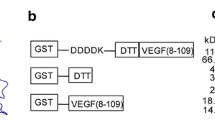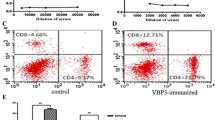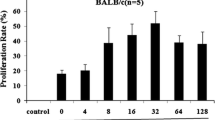Abstract
Lung cancer is the leading cause of mortality and 5-year survival rate is very low worldwide. Recent studies show that vascular endothelial growth factor receptor-3 (VEGFR-3) signaling pathway contributes to lung cancer progression. So we hypothesize that an oral DNA vaccine that targets VEGFR-3 carried by attenuated Salmonella enterica serovar typhimurium strain SL3261 has impacts on lung cancer progression. In this study, the oral VEGFR-3-based vaccine-immunized mice showed appreciable inhibition of tumor growth and tumor lymphatic microvessels in lung cancer mice model. Moreover, the oral VEGFR-3-based vaccine-immunized mice showed remarkable increases in both VEGFR-3-specific antibody levels and cytotoxic activity. Furthermore, the oral VEGFR-3-based vaccine-immunized mice showed a significant increase in the levels of T helper type 1 (Th1) cell intracellular cytokine expression (IL-2, IFN-γ, and TNF-α). After inoculation with murine Lewis lung carcinoma (LLC) cells, CD4+ or CD8+ T cell numbers obviously declined in control groups whereas high levels were maintained in the oral VEGFR-3-based vaccine group. These results demonstrated that the oral VEGFR-3-based vaccine could induce specific humoral and cellular immune responses and then significantly inhibit lung carcinoma growth via suppressing lymphangiogenesis.






Similar content being viewed by others
References
Siegel RL, Miller KD, Jemal A. Cancer statistics, 2015. CA Cancer J Clin. 2015;65(1):5–29. doi:10.3322/caac.21254.
Lee WS, Pyun BJ, Kim SW, Shim SR, Nam JR, Yoo JY, et al. TTAC-0001, a human monoclonal antibody targeting VEGFR-2/KDR, blocks tumor angiogenesis. MAbs. 2015;7(5):957–68. doi:10.1080/19420862.2015.1045168.
Zuo SG, Chen Y, Wu ZP, Liu X, Liu C, Zhou YC, et al. Orally administered DNA vaccine delivery by attenuated Salmonella typhimurium targeting fetal liver kinase 1 inhibits murine Lewis lung carcinoma growth and metastasis. Biol Pharm Bull. 2010;33(2):174–82.
Benedito R, Rocha SF, Woeste M, Zamykal M, Radtke F, Casanovas O, et al. Notch-dependent VEGFR3 upregulation allows angiogenesis without VEGF-VEGFR2 signalling. Nature. 2012;484(7392):110–4. doi:10.1038/nature10908.
Zhou HJ, Chen X, Huang Q, Liu R, Zhang H, Wang Y, et al. AIP1 mediates vascular endothelial cell growth factor receptor-3-dependent angiogenic and lymphangiogenic responses. Arterioscler Thromb Vasc Biol. 2014;34(3):603–15. doi:10.1161/ATVBAHA.113.303053.
Su JL, Yang PC, Shih JY, Yang CY, Wei LH, Hsieh CY, et al. The VEGF-C/Flt-4 axis promotes invasion and metastasis of cancer cells. Cancer Cell. 2006;9(3):209–23. doi:10.1016/j.ccr.2006.02.018.
Khromova N, Kopnin P, Rybko V, Kopnin BP. Downregulation of VEGF-C expression in lung and colon cancer cells decelerates tumor growth and inhibits metastasis via multiple mechanisms. Oncogene. 2012;31(11):1389–97. doi:10.1038/onc.2011.330.
Varney ML, Singh RK. VEGF-C-VEGFR3/Flt4 axis regulates mammary tumor growth and metastasis in an autocrine manner. Am J Cancer Res. 2015;5(2):616–28.
Zhang L, Zhou F, Han W, Shen B, Luo J, Shibuya M, et al. VEGFR-3 ligand-binding and kinase activity are required for lymphangiogenesis but not for angiogenesis. Cell Res. 2010;20(12):1319–31. doi:10.1038/cr.2010.116.
Chen F, Takenaka K, Ogawa E, Yanagihara K, Otake Y, Wada H, et al. Flt-4-positive endothelial cell density and its clinical significance in non-small cell lung cancer. Clin Cancer Res Off J Am Assoc Cancer Res. 2004;10(24):8548–53. doi:10.1158/1078-0432.CCR-04-0950.
Kojima H, Shijubo N, Yamada G, Ichimiya S, Abe S, Satoh M, et al. Clinical significance of vascular endothelial growth factor-C and vascular endothelial growth factor receptor 3 in patients with T1 lung adenocarcinoma. Cancer. 2005;104(8):1668–77. doi:10.1002/cncr.21366.
Li J, Yi H, Liu Z, Zhang H, Zhang D, Yue W, et al. Association between VEGFR-3 expression and lymph node metastasis in non-small-cell lung cancer. Exp Ther Med. 2015;9(2):389–94. doi:10.3892/etm.2014.2091.
Yang H, Kim C, Kim MJ, Schwendener RA, Alitalo K, Heston W, et al. Soluble vascular endothelial growth factor receptor-3 suppresses lymphangiogenesis and lymphatic metastasis in bladder cancer. Mol Cancer. 2011;10:36. doi:10.1186/1476-4598-10-36.
Decio A, Taraboletti G, Patton V, Alzani R, Perego P, Fruscio R, et al. Vascular endothelial growth factor c promotes ovarian carcinoma progression through paracrine and autocrine mechanisms. Am J Pathol. 2014;184(4):1050–61. doi:10.1016/j.ajpath.2013.12.030.
Hu J, Cheng Y, Li Y, Jin Z, Pan Y, Liu G, et al. MicroRNA-128 plays a critical role in human non-small cell lung cancer tumourigenesis, angiogenesis and lymphangiogenesis by directly targeting vascular endothelial growth factor-C. Eur J Cancer. 2014;50(13):2336–50. doi:10.1016/j.ejca.2014.06.005.
Chang YW, Su CM, Su YH, Ho YS, Lai HH, Chen HA, et al. Novel peptides suppress VEGFR-3 activity and antagonize VEGFR-3-mediated oncogenic effects. Oncotarget. 2014;5(11):3823–35.
Tiriveedhi V, Tucker N, Herndon J, Li L, Sturmoski M, Ellis M, et al. Safety and preliminary evidence of biologic efficacy of a mammaglobin-a DNA vaccine in patients with stable metastatic breast cancer. Clin Cancer Res Off J Am Assoc Cancer Res. 2014;20(23):5964–75. doi:10.1158/1078-0432.CCR-14-0059.
Lowe DB, Shearer MH, Kennedy RC. DNA vaccines: successes and limitations in cancer and infectious disease. J Cell Biochem. 2006;98(2):235–42. doi:10.1002/jcb.20775.
Toussaint B, Chauchet X, Wang Y, Polack B, Le Gouellec A. Live-attenuated bacteria as a cancer vaccine vector. Exp Rev Vaccines. 2013;12(10):1139–54. doi:10.1586/14760584.2013.836914.
Paterson Y, Guirnalda PD, Wood LM. Listeria and Salmonella bacterial vectors of tumor-associated antigens for cancer immunotherapy. Semin Immunol. 2010;22(3):183–9. doi:10.1016/j.smim.2010.02.002.
Grille S, Moreno M, Bascuas T, Marques JM, Munoz N, Lens D, et al. Salmonella enterica serovar Typhimurium immunotherapy for B-cell lymphoma induces broad anti-tumour immunity with therapeutic effect. Immunology. 2014;143(3):428–37. doi:10.1111/imm.12320.
Garmory HS, Griffin KF, Brown KA, Titball RW. Oral immunisation with live aroA attenuated Salmonella enterica serovar Typhimurium expressing the Yersinia pestis V antigen protects mice against plague. Vaccine. 2003;21(21–22):3051–7.
Liu XF, Hu JL, Quan QZ, Sun ZQ, Wang YJ, Qi F. Systemic immune responses to oral administration of recombinant attenuated Salmonella typhimurium expressing Helicobacter pylori urease in mice. World J Gastroenterol WJG. 2005;11(14):2154–6.
Jellbauer S, Panthel K, Hetrodt JH, Russmann H. CD8 T-cell induction against vascular endothelial growth factor receptor 2 by Salmonella for vaccination purposes against a murine melanoma. PLoS One. 2012;7(4):e34214. doi:10.1371/journal.pone.0034214.
Xiong G, Husseiny MI, Song L, Erdreich-Epstein A, Shackleford GM, Seeger RC, et al. Novel cancer vaccine based on genes of Salmonella pathogenicity island 2. Int J Cancer J Int Cancer. 2010;126(11):2622–34. doi:10.1002/ijc.24957.
Dong J, Yang J, Chen MQ, Wang XC, Wu ZP, Chen Y, et al. A comparative study of gene vaccines encoding different extracellular domains of the vascular endothelial growth factor receptor 2 in the mouse model of colon adenocarcinoma CT-26. Cancer Biol Ther. 2008;7(4):502–9.
Reisfeld RA, Niethammer AG, Luo Y, Xiang R. DNA vaccines suppress tumor growth and metastases by the induction of anti-angiogenesis. Immunol Rev. 2004;199:181–90. doi:10.1111/j.0105-2896.2004.00137.x.
Yi AK, Yoon JG, Hong SC, Redford TW, Krieg AM. Lipopolysaccharide and CpG DNA synergize for tumor necrosis factor-alpha production through activation of NF-kappaB. Int Immunol. 2001;13(11):1391–404.
Akira S, Takeda K, Kaisho T. Toll-like receptors: critical proteins linking innate and acquired immunity. Nat Immunol. 2001;2(8):675–80. doi:10.1038/90609.
Zhu X, Cai J, Huang J, Jiang X, Ren D. The treatment and prevention of mouse melanoma with an oral DNA vaccine carried by attenuated Salmonella typhimurium. J Immunother. 2010;33(5):453–60. doi:10.1097/CJI.0b013e3181cf23a6.
Xiang R, Mizutani N, Luo Y, Chiodoni C, Zhou H, Mizutani M, et al. A DNA vaccine targeting survivin combines apoptosis with suppression of angiogenesis in lung tumor eradication. Cancer Res. 2005;65(2):553–61.
Niethammer AG, Xiang R, Becker JC, Wodrich H, Pertl U, Karsten G, et al. A DNA vaccine against VEGF receptor 2 prevents effective angiogenesis and inhibits tumor growth. Nat Med. 2002;8(12):1369–75. doi:10.1038/nm794.
Kurenova EV, Hunt DL, He D, Fu AD, Massoll NA, Golubovskaya VM, et al. Vascular endothelial growth factor receptor-3 promotes breast cancer cell proliferation, motility and survival in vitro and tumor formation in vivo. Cell Cycle. 2009;8(14):2266–80.
Tammela T, Zarkada G, Wallgard E, Murtomaki A, Suchting S, Wirzenius M, et al. Blocking VEGFR-3 suppresses angiogenic sprouting and vascular network formation. Nature. 2008;454(7204):656–60. doi:10.1038/nature07083.
Shimizu K, Kubo H, Yamaguchi K, Kawashima K, Ueda Y, Matsuo K, et al. Suppression of VEGFR-3 signaling inhibits lymph node metastasis in gastric cancer. Cancer Sci. 2004;95(4):328–33.
Su JL, Chen PS, Chien MH, Chen PB, Chen YH, Lai CC, et al. Further evidence for expression and function of the VEGF-C/VEGFR-3 axis in cancer cells. Cancer Cell. 2008;13(6):557–60. doi:10.1016/j.ccr.2008.04.021.
Petrova TV, Bono P, Holnthoner W, Chesnes J, Pytowski B, Sihto H, et al. VEGFR-3 expression is restricted to blood and lymphatic vessels in solid tumors. Cancer Cell. 2008;13(6):554–6. doi:10.1016/j.ccr.2008.04.022.
Longatto Filho A, Martins A, Costa SM, Schmitt FC. VEGFR-3 expression in breast cancer tissue is not restricted to lymphatic vessels. Pathol Res Pract. 2005;201(2):93–9.
Bogos K, Renyi-Vamos F, Dobos J, Kenessey I, Tovari J, Timar J, et al. High VEGFR-3-positive circulating lymphatic/vascular endothelial progenitor cell level is associated with poor prognosis in human small cell lung cancer. Clin Cancer Res Off J Am Assoc Cancer Res. 2009;15(5):1741–6. doi:10.1158/1078-0432.CCR-08-1372.
Hu Q, Wu M, Fang C, Cheng C, Zhao M, Fang W, et al. Engineering nanoparticle-coated bacteria as oral DNA vaccines for cancer immunotherapy. Nano Lett. 2015;15(4):2732–9. doi:10.1021/acs.nanolett.5b00570.
Nakashima H, Terabe M, Berzofsky JA, Husain SR, Puri RK. A novel combination immunotherapy for cancer by IL-13Ralpha2-targeted DNA vaccine and immunotoxin in murine tumor models. J Immunol. 2011;187(10):4935–46. doi:10.4049/jimmunol.1102095.
Disis ML. Immune regulation of cancer. J Clin Oncol Off J Am Soc Clin Oncol. 2010;28(29):4531–8. doi:10.1200/JCO.2009.27.2146.
Shale M, Schiering C, Powrie F. CD4(+) T-cell subsets in intestinal inflammation. Immunol Rev. 2013;252(1):164–82. doi:10.1111/imr.12039.
Funding
This study was funded by grants from the National Natural Science Foundation of China (No. 81460358, No. 81060177, No. 81460441), the Joint Special Funds for the Department of Science and Technology of Yunnan Province-Kunming Medical University (No. 2012FB067), and the Yunnan Provincial Technology Project of Health (No. 2012WS0041, No. 2014NS024).
Compliance with ethical standards
ᅟ
Conflicts of interest
None
Ethical approval
All procedures performed in studies involving animals were in accordance with the ethical standards of the institution or practice at which the studies were conducted.
Author information
Authors and Affiliations
Corresponding author
Additional information
Yan Chen and Xin Liu contributed equally to this work.
Electronic supplementary material
Below is the link to the electronic supplementary material.
Fig. S1
The recombinant vector pcDNA3.1-VR-3 was successfully constructed, and verified by DNA sequencing and Western blotting. (a) DNA encoding VEGFR-3 extracellular domain was inserted into pcDNA3.1 vector between the restriction sites HindIII and XbaI and confirmed by DNA sequencing. DNA sequencing data showed that the recombinant gene matched the sequence in GenBank. (b) COS-7 cells were transiently transfected with the recombinant pcDNA3.1-VR-3 and the pcDNA3.1 empty vector respectively. Recombinant VEGFR-3 protein expression was confirmed by Western blotting in cell lysates at 24 h and 72 h after transfection. The protein appeared at approximately 180 kD. (GIF 61 kb)
Fig. S2
Attenuated S. typhimurium SL3261 can infect macrophage cell line Ana-1 in vitro, and disseminate from the gut to other parts of body. (a) Fluorescence and optical microscopic images of Ana-1 cells in vitro co-incubated with EGFP-expressing SL3261 or negative control cells (NTC) without any treatment. 24 h after co-incubation, cells were detected by inverted fluorescence microscopy. Both panels, ×200 magnification. (b) C57BL/6 J mice were immunized 3 times at 2-weeks intervals by oral administration of 108 CFU of SL3261 harboring pEGFP-C2 or saline. Mice were sacrificed 4 h, 8 h or 96 h after the last immunization. The percentage of EGFP-expressing cells derived from small intestine, liver and spleen were detected by flow cytometry (n = 3 per time point). Error bars indicate S.D. (GIF 107 kb)
Rights and permissions
About this article
Cite this article
Chen, Y., Liu, X., Jin, C.G. et al. An orally administered DNA vaccine targeting vascular endothelial growth factor receptor-3 inhibits lung carcinoma growth. Tumor Biol. 37, 2395–2404 (2016). https://doi.org/10.1007/s13277-015-4061-3
Received:
Accepted:
Published:
Issue Date:
DOI: https://doi.org/10.1007/s13277-015-4061-3




